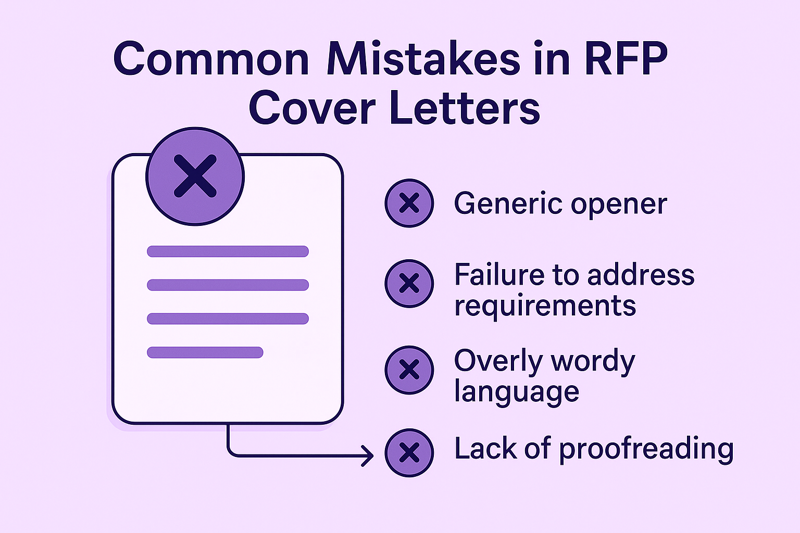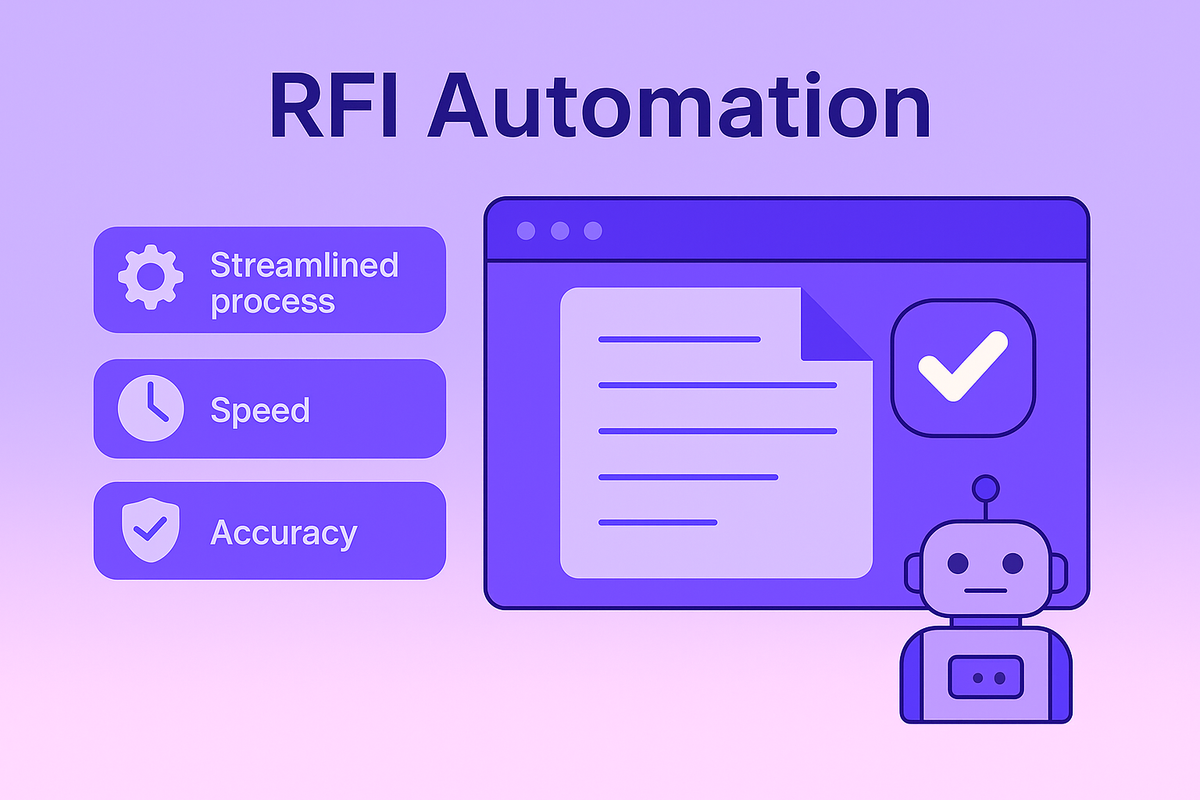Top Cover Letter RFP Mistakes & Tips
August 11, 2025
By
Evie Secilmis

Common Mistakes in RFP Cover Letters (and How to Avoid Them)
When competing for a contract, your Request for Proposal (RFP) cover letter is your first impression — and first impressions count. It’s your opportunity to capture attention, build trust, and set the tone for the rest of your proposal.
Unfortunately, many companies make mistakes that weaken their credibility and reduce their chances of winning the bid. A well-written RFP cover letter can set you apart, while a poorly crafted one can cost you the deal.
In this guide, we’ll cover the most common RFP cover letter mistakes, explain how to fix them, and share best practices to help you write a stronger, more persuasive introduction.
The Purpose of an RFP Cover Letter
An RFP cover letter is more than a formality — it’s your chance to introduce your company, highlight your qualifications, and show the client that you understand their goals.
Decision-makers often skim the cover letter first, forming an initial impression before diving into the full proposal. That means your letter must be concise, relevant, and tailored to the client’s needs.
If you’re new to RFPs, check out RFP 101: What Is a Request for Proposal? for a full overview of how the RFP process works and where your cover letter fits in.
Think of your cover letter as a handshake — firm, confident, and memorable. It should immediately signal professionalism, clarity, and enthusiasm for the opportunity.
1. Using a Generic Template
One of the most common — and costly — mistakes is using a generic cover letter for every RFP.
A templated, copy-paste approach signals a lack of effort and can instantly turn off evaluators. Instead, personalize each letter to the specific client and project. Mention:
- The client’s name and company
- The project title or focus
- Why your company is uniquely suited for their needs
This small touch shows that you’ve invested time in understanding their goals — and that you’re serious about earning their business.
For more guidance on personalization and structure, read Essential Elements of an RFP Cover Letter.
2. Overloading the Letter with Details
A cover letter should spark interest, not summarize every section of your proposal.
Many teams make the mistake of cramming too much information into one page. Instead, focus on the key highlights — your experience, your understanding of the project, and your value proposition.
Keep your cover letter short and compelling. The goal is to entice the reader to continue, not overwhelm them with technical details best left for the full proposal.
3. Ignoring RFP Instructions
Every RFP comes with specific guidelines — from formatting to word count to required sections.
Ignoring these instructions can raise red flags about your attention to detail. Review the RFP document carefully and ensure your cover letter:
- Follows the requested structure
- Addresses all required topics
- Meets any formatting or length requirements
Demonstrating that you can follow directions builds confidence in your ability to execute the project successfully.
4. Focusing Too Much on Yourself
Your cover letter isn’t just about your company — it’s about how your company can solve the client’s problems.
A common mistake is spending too much time listing your accomplishments without connecting them to the client’s goals. Instead, write from a client-first perspective:
“We understand your goal of streamlining operations, and our automation platform is designed to help teams like yours improve efficiency and accuracy.”
By emphasizing shared objectives and measurable outcomes, you make your proposal more relevant and persuasive.
5. Overcomplicating the Language
Clarity is more powerful than complexity.
Avoid jargon, acronyms, and overly technical explanations that might confuse your reader. Keep your tone professional but conversational, ensuring anyone — even non-technical reviewers — can understand your message.
A clear, straightforward style conveys confidence and professionalism while keeping the focus on your value.
6. Neglecting Proofreading
Even the most well-written letter can lose credibility if it’s riddled with typos or grammatical errors.
Mistakes in your cover letter suggest carelessness and undermine your attention to detail — a major red flag for clients evaluating project reliability.
Before submitting, always:
- Spell-check and grammar-check your letter
- Read it aloud to catch awkward phrasing
- Have a colleague review it for clarity and tone
A polished letter signals competence and professionalism from the very first line.
7. Forgetting a Call to Action
Another frequent mistake is failing to include a clear next step. Don’t let your letter fizzle out — guide the reader toward action.
End your RFP cover letter by inviting the client to:
- Review your proposal in detail
- Schedule a follow-up meeting
- Contact you directly with questions
Example:
“We’d welcome the opportunity to discuss how our team can bring your project vision to life. Please feel free to reach me directly at [email] or [phone number].”
This final touch keeps the momentum going and encourages engagement.
How to Strengthen Your RFP Cover Letter
Now that you know what to avoid, here’s how to elevate your next cover letter:
✅ Start strong: Open with a personalized greeting and a clear purpose.
✅ Be concise: Limit your cover letter to one page of focused, engaging content.
✅ Show alignment: Connect your expertise to the client’s specific goals.
✅ Proof and polish: Edit thoroughly before sending.
✅ End with confidence: Include a professional closing and clear call to action.
If you need a reference point, check out the structure and tone in Essential Elements of an RFP Cover Letter for a practical example.
Final Thoughts
Writing an effective RFP cover letter doesn’t have to be complicated — but it does require strategy, personalization, and attention to detail.
Avoiding common pitfalls like generic templates, unclear messaging, or lack of proofreading can dramatically improve your chances of winning the contract.
If you’d like to see how a strong cover letter should look, explore our RFP Cover Letter Template for structure, tone, and formatting guidance.
By crafting thoughtful, customized letters, you’ll not only improve your proposal’s reception but also position your company as a professional, trustworthy partner ready to deliver results.
Share this post
Link copied!




















